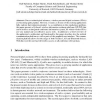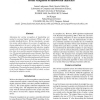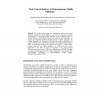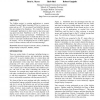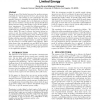MMS
2006
14 years 2 months ago
2006
: Due to technological advances, wireless personal digital assistants (PDAs) are becoming quite popular. However, it seems as if none of the existing applications fully exploits th...
CHI
2010
ACM
14 years 3 months ago
2010
ACM
In this paper, we report our findings on the adoption practices of used personal digital assistants (PDAs) to inform reuse of outdated computing products. Our interviews with 12 e...
NIPS
2001
14 years 3 months ago
2001
With the increasing number of users of mobile computing devices (e.g. personal digital assistants) and the advent of third generation mobile phones, wireless communications are be...
DCAI
2008
14 years 4 months ago
2008
In the context of artificial intelligence, the multiagent systems are an alternative solution to address complex problems and distributed. PAINALLI is an multi-agent architecture f...
ICANN
1997
Springer
14 years 6 months ago
1997
Springer
Subsystems for on-line recognition of handwriting are needed in personal digital assistants (PDAs) and other portable handheld devices. We have developed a recognition system whic...
COMPCON
1994
IEEE
14 years 6 months ago
1994
IEEE
The application architecture of Newton, a technology for supporting Personal Digital Assistants (PDAs), is described. It combines a dynamic, object-oriented language called Newton...
ER
1998
Springer
14 years 6 months ago
1998
Springer
It is widely acknowledged that information such as web content should be adapted for mobile platforms to account for restrictions in mobile environments. As emerging mobile platfor...
CSCW
1998
ACM
14 years 6 months ago
1998
ACM
The Pebbles project is creating applications to connect multiple Personal Digital Assistants (PDAs) to a main computer such as a PC. We are using 3Com PalmPilots because they are ...
ISLPED
2000
ACM
14 years 6 months ago
2000
ACM
Energy is one of the limited resources for modern systems, especially the battery-operated devices and personal digital assistants. The backlog in new technologies for more powerf...
DFG
2001
Springer
14 years 6 months ago
2001
Springer
: Bisher wurden für die Unterstützung der stereotaktischen Behandlung zentralmotorischer Störungen wie Tremor oder Dystonie Prozessrechner oder Personalcomputer eingesetzt. Dies...
